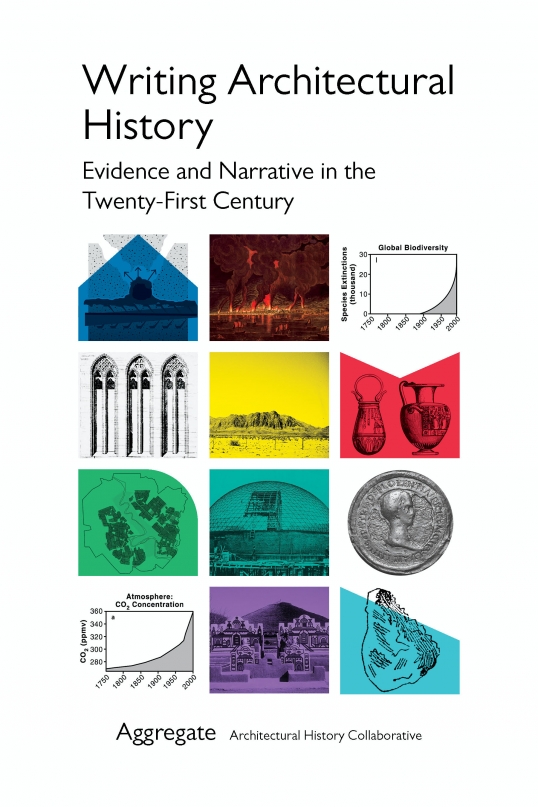Writing Architectural History: Evidence and Narrative in the Twenty-First Century
Cover of Writing Architectural History: Evidence and Narrative in the Twenty-First Century (University of Pittsburgh Press 2021).
Writing Architectural History: Evidence and Narrative in the Twenty-First Century
Published Dec. 2021 by the University of Pittsburgh Press
info • buy
What kinds of evidence does architectural history use? How is this evidence organized in different narratives and toward what ends? What might this tell us about disciplinary and institutional positions? And, how can consideration of evidence and narrative help us reimagine the limits and the potentials of the field? These are some of the questions addressed in Writing Architectural History: Evidence and Narrative in the Twenty-First Century, forthcoming from the University of Pittsburgh Press in December 2021. In this spirit, we asked the twenty-three contributors both to share their specific researches, from the medieval to the present around the world, and to consider broader questions of their modus operandi—the kinds of evidence they rely on and the tactics that they use for weaving that evidence into narratives. Examining the field’s claims to knowledge may help sharpen the specificity of our analyses and engage critically in the present, while opening new explorations in writing architectural history.
Contents
Introduction • Evidence, Narrative, and Writing Architectural History • Daniel M. Abramson, Zeynep Çelik Alexander, and Michael Osman for Aggregate
Part I: Legends
Chapter 1 • The Fires of Saint-Domingue, or, Landscapes of the Haitian Revolution • Peter Minosh
Chapter 2 • Known Unknowns: The Documentary History of the Franklin Ghost House • Edward Eigen
Chapter 3 • Vacuum Suction Conveyance, Part II • Meredith TenHoor
Part II: Self-Evidence
Chapter 4 • Talkative Timbers: A. E. Douglass, the Beam Expeditions, and the Construction of Architectural Evidence • Albert Narath
Chapter 5 • Concrete Is One Hundred Years Old: The Carbonation Equation and Narratives of Anthropogenic Change • Lucia Allais and Forrest Meggers
Chapter 6 • Medieval and Renaissance Money: On Trial, On Architecture • Lauren Jacobi
Part III: Data
Chapter 7 • From Truth to Proof: Friedrich Adler’s Medieval Brick Architecture of the Prussian States • Laila Seewang
Chapter 8 • The Banister Fletchers’ Tabulations • Zeynep Çelik Alexander and Michael Osman
Chapter 9 • Evidence and Narrative in Digital Art History: Exploratory Methods for Weimar Architecture • Paul B. Jaskot and Ivo van der Graaff
Part IV: Pairings
Chapter 10 • Comparative Architecture and Its Discontents • Roy Kozlovsky
Chapter 11 • When Baghdad Was Like Warsaw: Comparison in the Cold War • Łukasz Stanek
Chapter 12 • Forensic Architecture as Symptom • Andrew Herscher
Chapter 13 • Architectural History after Sebald’s Austerlitz: A Squirrel’s Hoard, a Curved Road • Daniel M. Abramson
Part V: Testimony
Chapter 14 • Failing Memories and Forgotten Histories: The Dispute over the Venetian Church of San Giobbe • Janna Israel
Chapter 15 • Settling Imaginations: Between Dust and Silt • Ijlal Muzaffar
Chapter 16 • Dadaab Is a Place on Earth: Land and the Migrant Archive • Anooradha Iyer Siddiqi
Chapter 17 • Learning from Johannesburg: Unpacking Denise Scott Brown’s South African View of Las Vegas • Ayala Levin
Part VI: Retrials
Chapter 18 • Architectural Narratives of Habeas Corpus on the High Seas: Charles Frederick Lees versus the Crown • Lisa Haber-Thomson
Chapter 19 • “This Whole Maze of Evidence”: Revisiting Professionalism and Property through Hunt v. Parmly” • Erik Carver
Chapter 20 • “Striking and Imposing Beauty”: On the Evidence of Aesthetic Valuation • Timothy Hyde
✓ Not peer-reviewed
